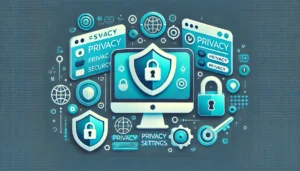Table of Contents
In today’s increasingly digital world, understanding and implementing comprehensive cybersecurity essentials is crucial for safeguarding your online privacy and securing your digital life. Cybersecurity encompasses a broad range of practices, technologies, and strategies designed to protect your devices, networks, and data from unauthorized access, misuse, or damage. With the growing reliance on technology for everyday tasks such as banking, shopping, and communication, data protection and information security have never been more important.
Key Takeaways
- Cybersecurity is indispensable in the modern digital landscape for ensuring online privacy and protecting sensitive information.
- It is not just technology but its effective utilisation that determines cybersecurity strength, emphasising the need for education and proactive behaviour.
- Recognising potential cyber threats and employing appropriate measures can significantly reduce the risk of personal and financial damage.
- Implementing robust password management, software updates, and secure network connections plays a pivotal role in fortifying your digital security.
- Continuously educating oneself about the latest trends and advancements in cyber safety empowers individuals to make informed decisions regarding their digital lives.
The Rising Importance of Cybersecurity in Our Daily Lives
Our modern, interconnected lives are vastly dependent on digital platforms for a myriad of purposes, including social media, online banking, and instant communication. As a result, it is crucial that we are aware of cyber threats and the importance of ensuring online safety, network security, and computer security. The implementation of appropriate measures for effective cyber risk assessment is our collective responsibility, in minimising the likelihood of security breaches that could result in significant personal and financial damage.
“In the 21st century, maintaining the security of our digital lives is as critical as locking our doors and setting our home alarm systems.”
One of the primary driving forces behind the rising importance of cybersecurity is the alarming increase in cybercrime. Ranging from data breaches and identity theft, to ransomware attacks and financial fraud, criminals are relentlessly seeking opportunities to exploit vulnerabilities in our digital environments. For this reason, it is vital that we proactively assess our online safety practices and strengthen our cybersecurity measures accordingly.
- Stay informed about recent cyber threats and trends
- Secure your digital devices with updated software and antivirus protection
- Create strong and unique passwords for your online accounts
- Examine your privacy settings on social media platforms
- Practice responsible online behaviour and avoid clicking on suspicious links
| Cyber Threat | Description | Preventive Measures |
|---|---|---|
| Malware | Malicious software designed to infiltrate and damage computer systems | Install and regularly update antivirus software |
| Phishing | Fraudulent communication aimed at obtaining sensitive information | Verify the source of the message and report suspicious emails to the appropriate authorities |
| Man-in-the-Middle Attacks | Interception and potentially alteration of communication between two parties | Utilise secure, encrypted connections and avoid public Wi-Fi for sensitive data transmission |
In conclusion, with the growing dependence on digital platforms and the increasing prevalence of cyber threats, understanding and addressing the importance of cybersecurity is critical in ensuring the safety and security of our daily lives. Through vigilance, education and the implementation of appropriate measures, we can protect ourselves and our assets from ever-evolving digital dangers.
Defining Cyber Threats: What Are You Up Against?
In an increasingly digital world, it is crucial to be familiar with various cyber threats and adopt appropriate cybersecurity measures to safeguard our devices and sensitive data. This section discusses three key hazards in the digital landscape: malware, phishing scams, and man-in-the-middle (MitM) attacks.

Malware: Viruses, Worms, and Trojans
Malware covers an extensive range of malicious software, including computer viruses, worms, and trojans. These threats are designed to infiltrate devices, cause damage, and potentially steal sensitive data. Antivirus software can offer robust protection against malware, but users must regularly update these solutions to ensure maximum effectiveness. Additionally, adopting cautious online behaviour and enhancing one’s cybersecurity awareness are essential for protecting against malware.
Phishing Scams: Identifying Fraudulent Communication
Phishing scams represent another significant threat to digital security. Cybercriminals use deceptive tactics, often through emails, phone calls, or texts, in attempts to impersonate legitimate entities and trick users into divulging sensitive information. Falling victim to these scams can lead to online fraud, so it is crucial to enhance email security and understand how to identify fraudulent communications. Increased data protection may also reduce the potential impact of phishing attacks.
Phishing scams are more prevalent than you might think. Vigilance and knowledge about how to identify such fraudulent communications are crucial for personal cybersecurity.
Man-in-the-Middle Attacks: When Eavesdropping Gets Digital
In Man-in-the-Middle (MitM) attacks, cybercriminals intercept and potentially alter communications between two unsuspecting parties. This form of eavesdropping can have severe consequences for your network security and sensitive information. Adopting secure communication practices, such as using encrypted connections, can help protect against MitM attacks and bolster your overall information security.
| Threat | Key Characteristics | Preventative Measures |
|---|---|---|
| Malware | Involves computer viruses, worms, and trojans; infiltrates devices and may steal sensitive data | Install and update reliable antivirus software; exercise caution online |
| Phishing Scams | Deceptive tactics through emails, phone calls, or texts; attempts to elicit sensitive information | Improve email security; learn to identify fraudulent communications |
| Man-in-the-Middle Attacks | Interception of communications between unsuspecting parties; can compromise network security | Utilise encrypted connections; adopt secure communication practices |
By understanding these common cyber threats and adopting appropriate cybersecurity measures, you can significantly enhance your digital security and protect your information from potential harm.
Your First Line of Defence: Passwords and Authentication Methods
As our reliance on digital platforms continues to grow, the significance of protecting our online accounts with strong passwords and robust authentication methods cannot be overlooked. A solid password foundation and two-factor authentication (2FA) contribute significantly to reducing the risk of unauthorised access and remaining aligned with cybersecurity best practices.
Disclaimer: The provided image demonstrates a secure password and SMS-based two-factor authentication for online accounts.
When creating passwords for your online accounts, it is essential to follow these guidelines for maximum security:
- Make use of a mix of upper-case and lower-case letters, numbers, and special characters.
- Never use easily guessable information such as birthdays, names or pet names.
- Ensure that each password is unique for each online account, avoiding reuse.
- Consider employing a reputable password manager for easier management and security.
Remember, a strong password serves as the primary defence against potential cyber threats targeting your online accounts.
Beyond using strong passwords, implementing two-factor authentication adds an extra layer of security to your online accounts. This additional step requires not only a password but also a second verification method, such as a unique code received via text message or an authenticator app. By leveraging two separate and distinct factors for authentication, the likelihood of unauthorised access is significantly decreased.
| Authentication Factor | Description | Examples |
|---|---|---|
| Something you know | Information that the user possesses | Password, PIN, Security Question |
| Something you have | A physical item that confirms the user’s identity | Mobile phone, USB Security Key, Smart card |
| Something you are | A biometric characteristic unique to the user | Fingerprint, Facial Recognition, Voice Recognition |
Utilising a combination of strong passwords and authentication methods is an integral component of your overall digital defence strategy. By adhering to these cybersecurity best practices, you can safeguard your online accounts and contribute to maintaining a secure digital ecosystem for yourself and others.
Keeping Your Devices and Data Current: The Role of Regular Updates
As technology evolves and cybercriminals devise new methods to exploit vulnerabilities, regular software updates become crucial in maintaining device security. These updates serve as a critical line of defence against harmful threats, ensuring that individuals and organisations continue to benefit from advanced cybersecurity measures.
One of the main reasons behind frequent software updates is the development and release of software patches. These patches are responsible for addressing known vulnerabilities and improving the performance of software, thereby playing a significant role in maintaining digital security.
The Significance of Software Patches
Software patches work by fixing security gaps, making it more difficult for potential attackers to exploit vulnerabilities. Timely installation of these patches is imperative to strengthen digital security as hackers often move quickly to exploit any known security flaws.
Cybersecurity experts recommend adopting a proactive approach to software updates, ensuring that devices and operating systems are frequently scanned for available patches and updating them when necessary. This practice demonstrates a level of commitment to cybersecurity that goes beyond basic digital hygiene.
Delaying software updates could result in significant consequences, exposing your devices and sensitive data to attackers who are well-versed in exploiting known vulnerabilities.
Some key benefits of consistent software updates and patch implementation include:
- Preventing malware infections and data breaches
- Protecting against targeted attacks that exploit weaknesses
- Maintaining compliance with industry regulations and standards
- Enhancing user experience through improved software performance

It is also worth noting that updates and patches are not limited to major software platforms such as operating systems and antivirus programs. Instead, they apply to various applications ranging from web browsers and plugins to content management systems. As such, users should be vigilant in updating the full suite of software running on their devices to achieve a comprehensive level of protection.
In conclusion, regular software updates, timely application of patches, and ongoing maintenance efforts are essential components of robust cybersecurity practices. By remaining proactive and vigilant in keeping devices and data current, individuals and organisations can significantly reduce their exposure to emerging threats and maintain a secure digital ecosystem.
The Necessity of Secure Networks and Safe Browsing
As we become increasingly connected online, the importance of using secure networks and practising safe browsing habits cannot be overstated. Implementing effective security measures is vital for preventing unauthorised access to personal data and upholding a robust digital defence against cyber threats. This section explores the significance of secure networks, safe browsing practices, and other crucial strategies for fortifying your virtual safety in this digital age.
Remember: Secure networks and safe browsing practices are essential components of comprehensive cybersecurity.
For uninterrupted protection of your sensitive information while browsing the internet, using a Virtual Private Network (VPN) is highly recommended. VPNs allow for secure, encrypted connections, shielding your data from prying eyes and hiding your IP address to maintain digital privacy even in unsecured locations. Additionally, VPNs help bypass geographic restrictions, enabling access to content unavailable in your region.
Public Wi-Fi networks are a double-edged sword. Although they provide convenient internet access, they also pose significant cybersecurity risks. Cybercriminals can exploit weak network security to intercept and steal your data or spread malware to unsuspecting devices. Here are a few essential tips for ensuring Wi-Fi security while using public networks:
- Use a VPN to encrypt data transmissions
- Ensure all websites use HTTPS connections
- Disable automatic connection to unfamiliar networks
- Avoid accessing sensitive accounts or inputting personal data while connected
In addition to these strategies, it’s crucial to adopt prudent cyber risk management habits. This includes ensuring that your devices are updated with the latest security patches and using robust antivirus software to protect against malware threats. Moreover, cultivating meticulous online habits such as scrutinising emails for potential phishing attempts and employing strong, unique passwords for each of your accounts can significantly bolster your overall cybersecurity posture.
Key takeaway: Secure networks, VPN usage, and safe browsing practices are indispensable for robust digital protection.
| Tips for Secure Browsing | Benefits |
|---|---|
| Utilise a VPN | Encrypts data transmissions and hides IP address |
| Ensure HTTPS connections on websites | Provides a secure browsing environment |
| Disable automatic connection to unfamiliar networks | Prevents unwanted connection to potentially harmful networks |
| Limit access to sensitive accounts on public Wi-Fi | Reduces the risk of data theft or unauthorised access |
To conclude, creating a secure digital environment is not only about the technology you employ but also about maintaining safe browsing practices, conscious decision-making, and diligent cyber risk management. By incorporating these approaches into your daily routine, you are significantly enhancing your defence against potential attacks, fostering a safer online experience for yourself and the entire digital community.
Going Beyond the Basics: Advanced Cybersecurity Measures
As the digital landscape continues to evolve and cyber threats become more sophisticated, it is crucial to adopt advanced cybersecurity measures for enhanced protection. Two critical components in any cybersecurity strategy are firewalls and antivirus software. Additionally, data encryption plays a vital role in ensuring the confidentiality and security of sensitive information.
Understanding Firewalls and Antivirus Solutions
Firewalls serve as digital gatekeepers, monitoring and controlling the flow of data between devices and external networks. They sift through incoming and outgoing traffic and help prevent unauthorized access, safeguarding sensitive information and maintaining the integrity of computer systems.
Antivirus solutions, on the other hand, act as a digital immune system. They scan files and programs for known viruses, malware, and other forms of malicious software. Once detected, threats are quarantined, neutralised, or removed to ensure the safety and performance of devices.
The Power of Encryption in Protecting Your Data
Data encryption is a powerful tool that encodes readable information into an unreadable format, decipherable only with the correct key. With advancements in encryption software, various cybersecurity strategies have been developed to provide secure data transmission and protect sensitive information.
“Encryption ensures that sensitive data remains secure during storage and transmission, preventing unauthorized access and maintaining confidentiality.”
Encryption can be applied to different scenarios, including:
- Encrypting email messages for secure communication
- Protecting files stored on a computer or external devices
- Securing data transmission over networks, including Wi-Fi or the internet
| Encryption Technique | Description |
|---|---|
| Symmetric-key encryption | Both sender and recipient share a single encryption key, which is used for both encryption and decryption. |
| Asymmetric-key encryption | Uses a pair of encryption keys (private and public). The public key is used for encryption, and the private key is used for decryption. |
| End-to-end encryption | Data is encrypted on the sender’s device, remains encrypted during transmission, and is only decrypted on the recipient’s device. |
Investing in advanced cybersecurity measures such as firewalls, antivirus solutions, and data encryption not only helps maintain the security of your devices and networks but also ensures the confidentiality and protection of sensitive information against ever-evolving cyber threats.
Social Media Wisdom: Protecting Your Digital Persona
In today’s interconnected world, protecting one’s digital persona has become increasingly important. By properly managing privacy settings and regulating information sharing, we can strengthen our social media security and prevent unwanted access to our personal data.
Privacy Settings and Information Sharing
It is essential to be proactive in keeping your personal information secure on social media platforms. Begin by customising your privacy settings to limit visibility and restrict access to only those you trust. Closely examine the permissions granted to third-party applications and ensure they align with your privacy expectations.

Aside from configuring privacy settings, managing information sharing control is vital in securing your digital persona. To help you achieve this, consider the following practical steps:
- Refrain from posting sensitive information, such as your home address, phone number, and email.
- Avoid disclosing your current location or future travel plans, as this may expose your home to potential burglars.
- Think twice before sharing photos or posts that may later cause embarrassment or harm your digital identity protection.
- Be cautious about accepting friend requests from individuals you don’t know or have no mutual connections with.
Remember: Once information is shared online, it is challenging to control who can access it or how it may be used in the future.
Part of effective online presence management is learning from others and staying informed about the latest social media privacy features. Regularly review and update your settings to accommodate new options introduced by the platforms. Additionally, encourage your friends and family members to adopt similar practices to cultivate a culture of online privacy and security.
Continuous Education: Staying Informed on Cybersecurity Trends

Cybersecurity is a dynamic field, with new threats and trends constantly emerging. Staying informed through resources such as webinars, newsletters, and authoritative blogs is essential for keeping up to date with current cybersecurity measures and practices. In this increasingly digitised world, continuous education plays a crucial role in enhancing one’s defences against cyber attacks and maintaining online safety.
Education is the key to unlocking the potential of cybersecurity in our daily lives. By staying up to date with the latest cybersecurity trends, individuals will be better equipped to protect their digital assets and take advantage of new methods and technologies designed to bolster security.
“Knowledge is power. Information is liberating. Education is the premise of progress, in every society, in every family.” – Kofi Annan
Let’s explore some practical ways to stay informed and boost your cyber awareness:
- Subscribe to industry newsletters such as those offered by the National Cyber Security Centre (NCSC), Infosecurity Magazine, and Krebs on Security.
- Follow cybersecurity experts and organisations on social media platforms, like Twitter or LinkedIn. Examples include Brian Krebs, Mikko Hypponen, and Bruce Schneier.
- Attend webinars and online training sessions from reputable sources, such as Cybersecurity & Infrastructure Security Agency (CISA), to expand your understanding of digital security techniques.
- Enrol in formal courses or certifications on cybersecurity, such as the Certified Information Systems Security Professional (CISSP) or CompTIA Security+.
| Resource | Description |
|---|---|
| National Cyber Security Centre (NCSC) Newsletter | A UK-based organisation offering insights into cybersecurity threats and trends, best practices, and guidance for individuals and businesses. |
| Infosecurity Magazine | A popular source of news, analysis, and expert insight on cybersecurity topics, available both online and in print. |
| Krebs on Security | An influential cybersecurity blog by investigative journalist Brian Krebs, covering in-depth analysis of cybersecurity incidents and trends. |
| Cybersecurity & Infrastructure Security Agency (CISA) | A US government agency providing webinars, information, resources, and training on various cybersecurity topics and best practices. |
In summary, staying informed of digital security updates and advancements in cybersecurity can help individuals and organisations strengthen their defences and protect their valuable data. By engaging in continuous education, you’ll be better equipped to navigate the ever-evolving landscape of cybersecurity risks and trends.
Conclusion – Cybersecurity
As we increasingly rely on digital platforms for numerous aspects of our lives, the importance of cybersecurity cannot be overstated. Recognising and embracing secure online practices and digital vigilance is vital for safeguarding our digital assets from ever-evolving threats. By proactively taking control of our cybersecurity measures, we can contribute to a safer online experience for everyone.
Incorporating a combination of technology and continuous learning in our daily digital routines is central to a comprehensive cybersecurity strategy. Understanding the nuances of cybersecurity and implementing multi-layered security measures will help mitigate risks and ensure a more secure digital experience. This includes adopting strong passwords, regular software updates, secure browsing practices, and utilising advanced cybersecurity tools such as firewalls and encryption.
Ultimately, securing our digital lives is an ongoing process that requires constant vigilance and adaptability, as cyber threats continue to evolve. Staying informed about the latest trends and practices in cybersecurity enables us to stay ahead of potential risks and protect our valuable information. By working together and prioritising cybersecurity, we empower ourselves and our online community to navigate the digital world with confidence and safety.
FAQ – Cybersecurity
What are the essentials of cybersecurity?
Cybersecurity essentials include digital security, data protection, securing one’s digital life, online privacy, and information security.
Why is cybersecurity becoming more important in our daily lives?
With increasing dependence on digital platforms for various purposes such as social media, financial transactions, and work, cybersecurity is becoming more important to protect against risks and breaches that can lead to significant personal and financial damage.
What are some common cyber threats we should be aware of?
Some common cyber threats include malware (viruses, worms, and trojans), phishing scams, and man-in-the-middle (MitM) attacks.
How can we strengthen our first line of defence against cyber attacks?
Implementing strong, unique passwords, and enhancing security through two-factor authentication for different accounts significantly reduces vulnerability to cyber attacks.
Why are regular updates to software and operating systems important?
Regular updates help close security loopholes exploited by cybercriminals. Software patches address known vulnerabilities, and their timely application is crucial for maintaining device and data security.
What can we do to ensure secure networks and practice safe browsing?
Using secure networks, employing VPNs, being cautious on public Wi-Fi networks, and practising safe browsing habits are essential for preventing unauthorised access to personal data.
What are some advanced cybersecurity measures we should consider?
Advanced cybersecurity measures include using firewalls, antivirus software, and employing encryption to protect sensitive data.
How can we protect our digital personas on social media platforms?
Managing privacy settings, regulating information sharing, and being mindful of friend requests from unknown individuals are crucial for protecting one’s digital persona on social media.
How can we stay informed about cybersecurity trends?
Staying informed through resources such as webinars, newsletters, and authoritative blogs is essential for keeping up to date with current cybersecurity measures and practices.
Source Links – Cybersecurity
- https://ischoolonline.berkeley.edu/blog/how-to-secure-your-digital-life-in-2021/
- https://arstechnica.com/features/2021/10/securing-your-digital-life-part-1/









